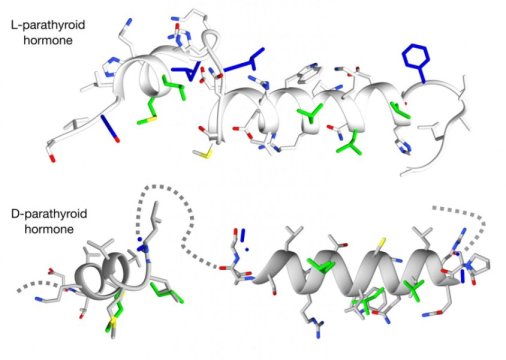Scientists, from the German Cancer Research Center (DKFZ), have successfully reconstructed biomolecules in the form of images. The goal of the researchers is to create a mirror artificial protein synthesis system. In other words, their goal is to produce mirrored therapeutic proteins, such as antibodies, that prevent biodegradation in the body and do not trigger any immune response.
Almost all biomolecules have two different spatial structures, which are related to each other, such as images and mirrors. These molecules are called enantiomers. Just like a person’s right hand and left hand, they cannot be superimposed on each other. Depending on the direction in which molecules rotate through polarized light, they are called D-enantiomers (right) or L-enantiomers (left). Although almost all proteins found in nature are composed of L-amino acids, DNA and RNA are constructed from D-molecules.
Scientists from the German Cancer Research Centre in Heidelberg are working to synthesize biomolecules in the form of images. In the future, they intend to build more than just a single molecule: “our long-term goal is to create simple artificial biological systems in the form of mirrors, corresponding to those in nature, but not interacting with the environment,” said Jörg, the project leader.
In their current work, scientists led by Hoheisel have been able to produce mirrored versions of DNA ligases from D-amino acids. Ligase binds DNA fragments together. Mirror ligase can form a complete mirror gene from the same mirror DNA fragment. More DNA replicates DNA and transcribes it into RNA, which is also available. “That’s what we are doing right now,” Hoheisel reports. “next, we need a mirror structure that performs the function of the cell’s ribosome. ”
Ribosomes are macromolecular complexes in cells that translate RNA chains into amino acid chains to produce proteins. “Once we generate mirror ribosomes, we develop a simple system that makes it easy for us to produce any type of protein,” Hoheisel said. “artificial systems will be independent of nature but will be the same in all biophysical and chemical characteristics, and may eventually lead to archetypal, mirrored replication of cells. ”
While this is still a vision for a more distant future, basic methods may have been used for therapeutic purposes in the near future, such as synthetic mirror antibodies. Today, these therapeutic immune proteins are synthesized and used as drugs to treat many diseases, including cancer. However, the patient’s immune system may produce body antibodies against therapeutic antibodies. “for the body, they are ultimately foreign invaders and have to fight like pathogens,” Hoheisel explained. “Antibody drugs consisting of mirrored D-amino acids instead of natural L-amino acids may not cause any immune response because the immune system does not recognize D-molecules. ”
In addition, mirror antibodies can have therapeutic activity for a long time because they break down very slowly in vivo. They can also be easily taken as pills because digestive enzymes in the body do not affect them.

